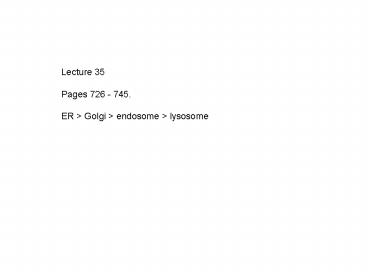Pages 726 745' - PowerPoint PPT Presentation
1 / 18
Title:
Pages 726 745'
Description:
Transport from the ER through the Golgi Apparatus - continuation of the ... are degraded in the lysosome arrive by endocytosis, phagocytosis, or autophagy. ... – PowerPoint PPT presentation
Number of Views:55
Avg rating:3.0/5.0
Title: Pages 726 745'
1
Lecture 35 Pages 726 - 745. ER gt Golgi gt
endosome gt lysosome
2
Transport from the ER through the Golgi Apparatus
- continuation of the biosynthetic-secretory
pathway.
Properly folded proteins are loaded into COPII
transport vesicles, while unfolded proteins
remain associated with chaperones in the ER until
folding is complete.
3
If a protein doesnt achieve a properly folded
state, it gets exported from the ER into the
cytosol where it is degraded by the proteosome.
4
When the protein is properly folded, COPII coated
vesicles transport the proteins via the vesicular
tubular cluster (vtc) to the cis-Golgi network.
- The COPII coating is removed (Sar1 hydolyzes GTP)
and the vesicles fuse with each other to form the
vtc. - The vtc is motored along microtubules that
function like railroad tracks. - The vtc fuses with the cis-Golgi network.
5
Some proteins exiting the ER are returned to the
ER by COPI coated vesicles. These proteins are
identified by the presence of specific signal
sequences that interact with the COPI vesicles or
associate with specific receptors.
- Examples of retrieved proteins
- v-SNAREs from the ER.
- ER chaperones like BiP that are mistakenly
transported.
This example describes the situation of BiP. BiP
has the signal sequence, KDEL. When BiP escapes
the ER, it associates with the KDEL receptor.
The slightly acid environment of the vtc and
Golgi favor this association. When the returning
vesicle fuses with the ER, the neutral pH of the
ER causes BiP to dissociate from the receptor.
6
Proteins exiting the ER join the Golgi apparatus
at the cis Golgi network. The Golgi apparatus
consists of a collection of stacked compartments.
7
The Golgi Apparatus has two major functions 1.
Modifies the N-linked oligosaccharides and adds
O-linked oligosaccharides. 2. Sorts proteins so
that when they exit the trans Golgi network, they
are delivered to the correct destination.
8
Modification of the N-linked oligosaccharides is
done by enzymes in the lumen of various Golgi
compartments.
While N-linked glycosylation appears to function
in monitoring protein-folding in the lumen of the
ER, the function of the oligosaccharide
modifications occurring in the Golgi is largely
unknown.
9
O-linked glycosylation involves the covalent
attachment of oligosaccharides to particular
serine and threonine side-chains. Mucus is an
example of a protein that is heavily O-linked
glycosylated and functions to provide a
protective layer over many epithelia.
10
(No Transcript)
11
(No Transcript)
12
One ultimate destination of some proteins that
arrive in the TGN is the lysosome. These
proteins include acid hydrolases.
Lysosomes are like the stomach of the cell. They
are organelles surrounded by a single membrane
and filled with enzymes called acid hydrolases
that digest (degrade) a variety of
macromolecules. A vacular H ATPase pumps
protons into the lysosome causing the pH to be
5.
13
The macromolecules that are degraded in the
lysosome arrive by endocytosis, phagocytosis, or
autophagy.
14
In plants, a specialized lysosome called a
vacuole controls the water pressure that presses
the cell against the cell wall.
15
Newly synthesized proteins destined for the
lysosome are first transported to the late
endosome.
16
The acid hydrolases in the lysosome are sorted in
the TGN based on the chemical marker mannose
6-phosphate.
Hydrolases are transported to the late endosome
which later matures into a lysosome.
Adaptins bridge the M6P receptor to clathrin.
Acidic pH causes hydrolase to dissociate from the
receptor.
17
Mannose 6-phosphate tag.
The phosphate is added in the Golgi
This was first attached in the ER.
18
The creation of the M6P marker in the Golgi
relies on recognition of a signal patch in the
tertiary structure of the hydrolase.
Patients with a disease called inclusion-cell
disease have cells lacking hydrolases in their
lysosomes. Instead, the hydrolases are found in
the blood. These patients lack GlcNAc
phosphotransferase. Without the M6P-tag, the
acid hydrolases are transported to the plasma
membrane instead of the late endosome.































